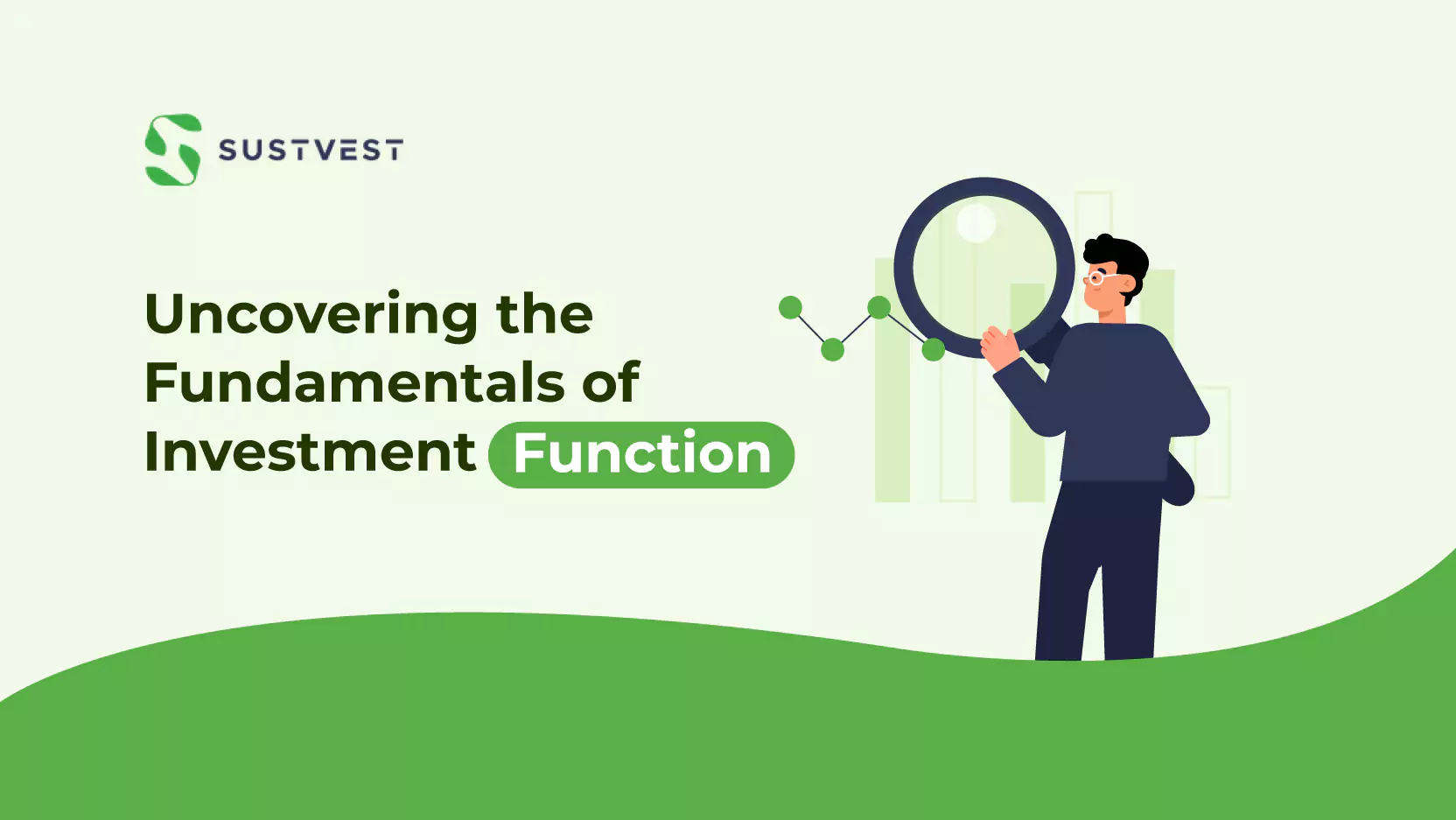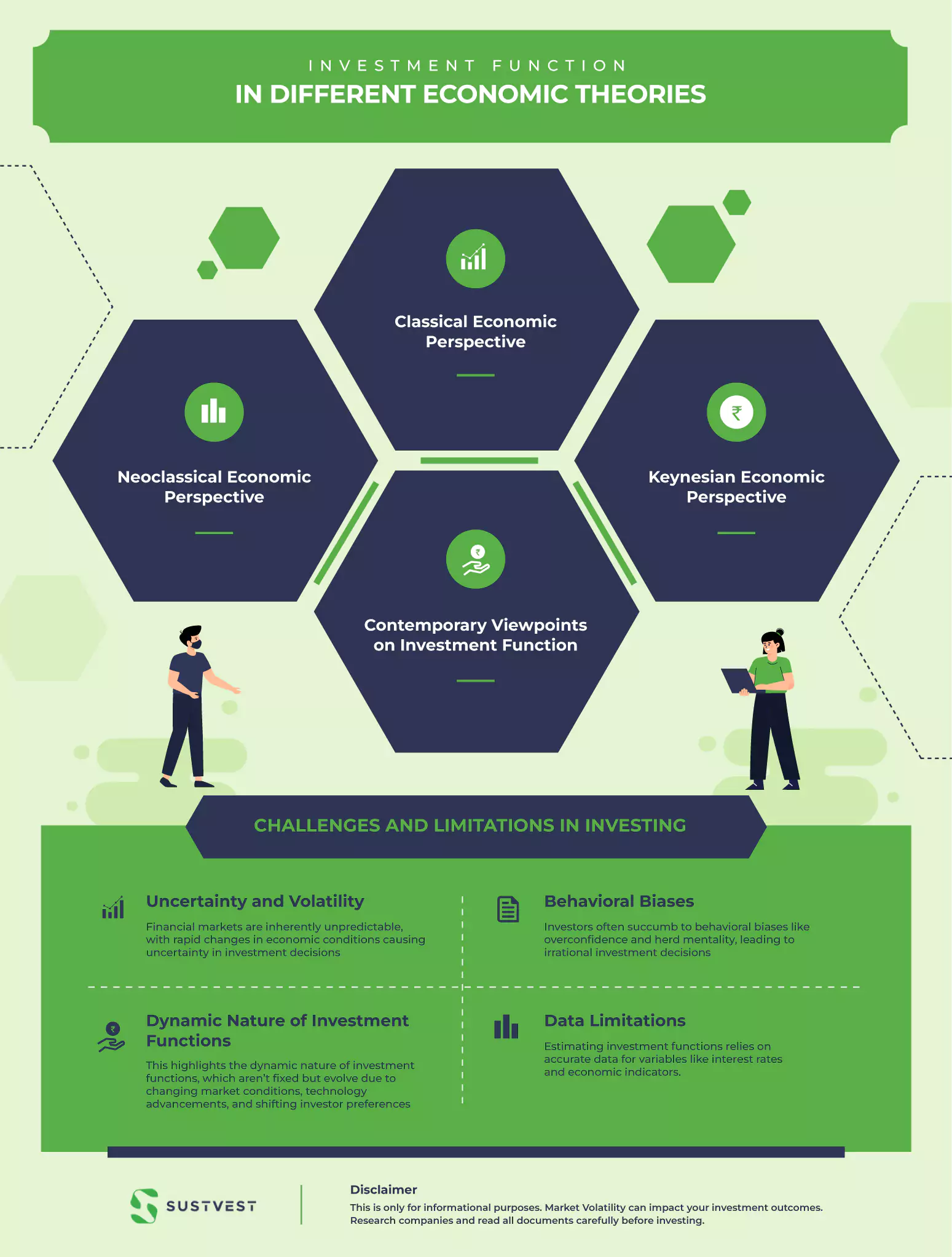Have you ever wondered how your savings contribute to building a better economy?
Imagine a puzzle where each piece represents a financial decision that shapes the growth of a nation.
This puzzle is the investment function, a fundamental concept in finance and economics. Just like a plant needs water and sunlight to thrive, economies need investments to blossom.
From small entrepreneurs to large corporations, everyone grapples with questions like: How do interest rates impact investment?
How does the overall economic outlook play a role?
Through this article, we’ll go on a journey to uncover the core principles of the function of investment and what is investment function. By studying investment decision-making elements, macroeconomic issues, and economic theories, we can navigate the complex world of investing.

What is Investment Function?
In the world of economics, there’s a nifty tool called the Investment Function that acts like a treasure map. It helps us understand how changes in people’s spending on investments connect to different factors that impact an economy.
Imagine it as a bridge between how people choose to invest their money and how this affects the bigger economic picture.
Investment, in simple terms, is when money is spent to create new things like buildings, machines, and stuff needed for production. Think of it as planting seeds that grow into more stuff for the economy.
We can split this spending into two types:
- Induced Investment: This happens when investments change because of how the economy is doing. If the economy is buzzing, people are more likely to invest.
- Autonomous Investment: Here, investments change independently. It’s like a decision made without waiting for the economy’s mood.
Understanding these investment categories helps economists predict how an economy will grow or slow down. It’s like seeing the future by reading investment patterns.
Therefore, understanding this function is vital to comprehend why investment is important. Investment drives economic growth, job creation, and technological advancement, fostering long-term prosperity.
What is the Investment Demand Function?
The investment demand function is a concept in economics that relates the level of investment spending to various factors, including the prevailing interest rate, expected returns on investment, and business expectations about future economic conditions.
It helps in understanding how changes in these factors influence the level of investment in an economy.
Mathematically, the investment demand function can be expressed as follows:
Investment = f(Interest Rate, Expected Returns, Business Expectations)
Components of Investment Function
Investment decisions are like the building blocks of a thriving economy. Understanding the components that shape these decisions is key to unravelling the investment function’s complexity.
Let’s examine the key aspects that affect investment decisions and the types of investments that boost economic growth.
- Interest Rates: Like you could save money in a bank with a higher interest rate, businesses consider how much they might gain from their investments.
- Economic Outlook: Imagine looking at the weather forecast before planning a picnic. Similarly, businesses consider how the economy is doing before deciding to invest. If things look good, they’re more likely to invest.
- Risk Assessment: Think about how you’d think twice before buying a very expensive toy that might break easily. Businesses also think about the risks before investing a lot of money.
- Industry Trends: Picture a popular toy becoming trendy – lots of people want it, so it’s a good idea to invest in making more. Businesses keep an eye on trends in their industries to make smart investment choices.
Investment Function and Macroeconomic Factors
When we talk about how investments work, we also need to think about bigger things that can affect them. These bigger things are called “macroeconomic factors.”
They are like the background that can change how investments behave.
Saving and Investing Together
Think of saving as keeping some money aside, like in a piggy bank. Now, investing is like using that saved money to buy something that can grow in value over time, like a plant that grows bigger and gives you more fruits.
The way people save and invest can change when the bigger economy shifts.
The intertwining concepts of saving and investing lead to a common dilemma: Saving Money Vs Investing – Which Is Best for Your Future? Explore to find out.
Government and Their Rules
The government creates rules that can affect investments. These rules might involve taxes or how much money the government spends. Changes in these rules can impact how much people want to invest.
If the government makes investing more attractive by reducing taxes or encouraging certain industries, people might be more likely to invest their money.
Other Countries and the World
Changes in other countries can affect investments too. If the global economy is weak, people might be cautious about investing.
Also, when one country’s money becomes more or less valuable than another’s, it can impact investment choices. So, international stuff matters for investments too.
Investment Function in Different Economic Theories
The investment function is like a puzzle piece that fits into different economic theories. These theories help us understand how investment works in the bigger picture of economics.
Let’s look at some of these theories in simpler words:
1. Classical Economic Perspective
According to the classical perspective, interest rates exert a significant influence on investment.
When interest rates are at a lower level, the cost of borrowing funds for investment purposes decreases, hence encouraging enterprises to engage in greater investment activities.
This phenomenon can be attributed to the decrease in borrowing costs, which in turn makes possible investment returns more appealing.
2. Keynesian Economic Perspective
The Keynesian theory claims that investment is significantly influenced by individuals’ expenditure levels and their confidence in the overall state of the economy.
Businesses gain confidence and are more inclined to invest in their growth and development when individuals are spending a lot and are hopeful about the future.
3. Neoclassical Economic Perspective
Neoclassical economists look at investment from a supply and demand angle. They think that the demand for investment funds depends on the potential profit businesses can make.
On the other hand, the supply of funds comes from people who save money.
4. Contemporary Viewpoints on Investment Function
Nowadays, economists combine ideas from different theories. They realise that many factors, like interest rates, confidence, and profits, influence investment.
They also consider how the government’s actions and global events can affect investment decisions.
Methods for Estimating Investment Functions
Estimating investment functions can be done using Empirical methods and studying data over time.
Empirical methods use real data to explain phenomena. These strategies help us understand investment functions by studying patterns and correlations between components.
One common empirical method is called “regression analysis.” Imagine you have a bunch of data about investments and other related things like interest rates, economic conditions, and risks.
Regression analysis helps you find out if changes in these factors are connected to changes in investments. It’s like drawing a line that best fits the data points and helps you see how they influence each other.
Another way to estimate investment functions is by studying data over time, which is called “time series data.” This involves comparing investments over time. This data shows how economic growth and market changes affect investment decisions.
Challenges and Limitations in Investing
Understanding the investment function is crucial to making smart financial decisions, but it’s necessary to recognise its drawbacks. These issues can affect investment estimates and strategy implementation.
This section discusses the investing function’s main issues and limitations:
1. Uncertainty and Volatility
Financial markets are inherently unpredictable, with rapid changes in economic conditions causing uncertainty in investment decisions.
Factors like geopolitical events and unexpected shocks can introduce significant volatility, making accurate predictions difficult.
This uncertainty challenges investors’ ability to anticipate market movements and unexpected events can disrupt the investment function’s expected outcomes, affecting investment strategies’ effectiveness.
2. Behavioral Biases
Investors often succumb to behavioral biases like overconfidence and herd mentality, leading to irrational investment decisions. These biases stem from emotions rather than rational analysis, distorting predictions based on the investment function.
Recognizing and addressing these biases is crucial for accurate decision-making and aligning investments with actual market trends.
3. Dynamic Nature of Investment Functions
This highlights the dynamic nature of investment functions, which aren’t fixed but evolve due to changing market conditions, technology advancements, and shifting investor preferences.
Predicting how these changes impact the function proves challenging, as historical data might not fully capture future trends, emphasizing the need to adapt strategies to the evolving landscape of investment opportunities.
The dynamic investment environment prompts a critical question: Short-Term vs Long-Term Investing – Which is Best For Your Future? Delve into this to strategize wisely.
4. Data Limitations
Estimating investment functions relies on accurate data for variables like interest rates and economic indicators.
Flawed or incomplete data can lead to unreliable models, undermining the quality of investment decisions.
Poor data quality can result from inaccuracies in data collection, gaps in historical records, or inadequate coverage of relevant factors, all of which compromise the function’s predictive capacity.

FAQs
How do interest rates affect investment functions?
Higher interest rates can discourage investments as borrowing becomes costlier, while lower rates can encourage more borrowing and investment.
Can government policies impact investment functions?
Yes, government policies like taxes and spending can influence investment decisions, affecting economic growth and business activities.
What’s the link between savings and investment functions?
Savings provide the funds for investments, and the balance between saving and investing affects overall economic health.
Conclusion
Grasping the basics of investment functions is crucial for anyone seeking financial growth. From the factors that sway investment choices to the way economies and policies influence them, it’s a dynamic realm.
As you navigate this landscape, remember that understanding what is investment function can help you make wiser decisions and manage risks.
As you forge ahead in your financial journey, never overlook the importance of How to Choose the Right Investment for Your Needs. Wisdom lies in choice.
To explore sustainable investment opportunities, check out SustVest—an avenue to align your investments with your values.

Founder of Sustvest
Hardik completed his B.Tech from BITS Pilani. Keeping the current global scenario, the growth of renewable energy in mind, and people looking for investment opportunities in mind he founded SustVest ( formerly, Solar Grid X ) in 2018. This venture led him to achieve the ‘Emerging Fintech Talent of the Year in MENA region ‘ in October 2019.




